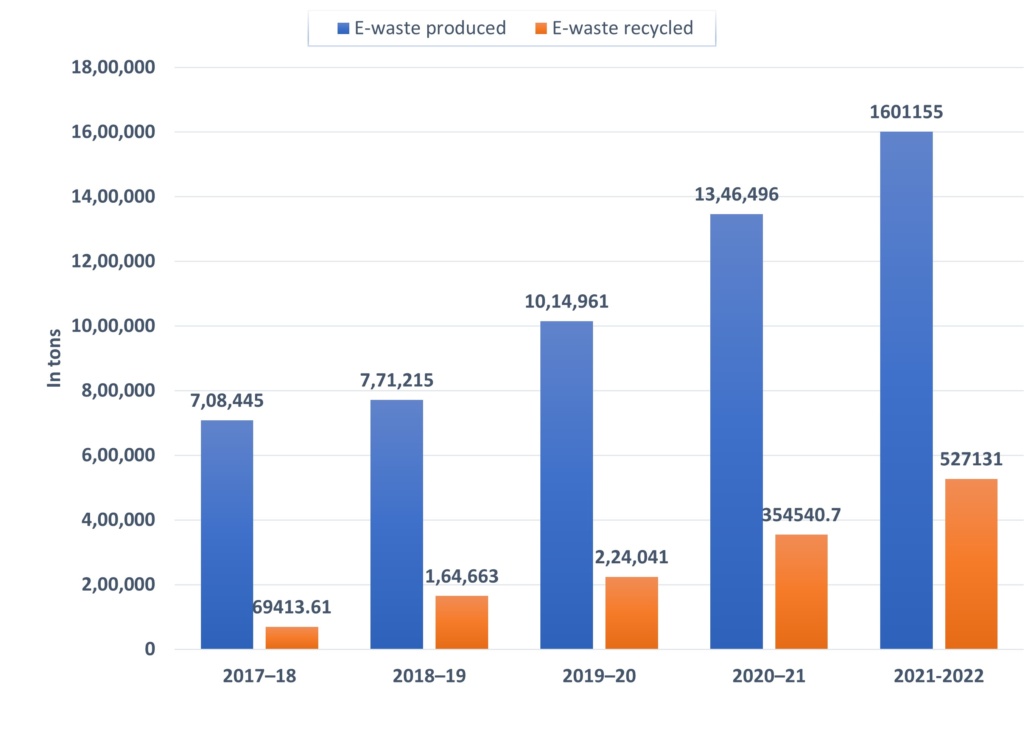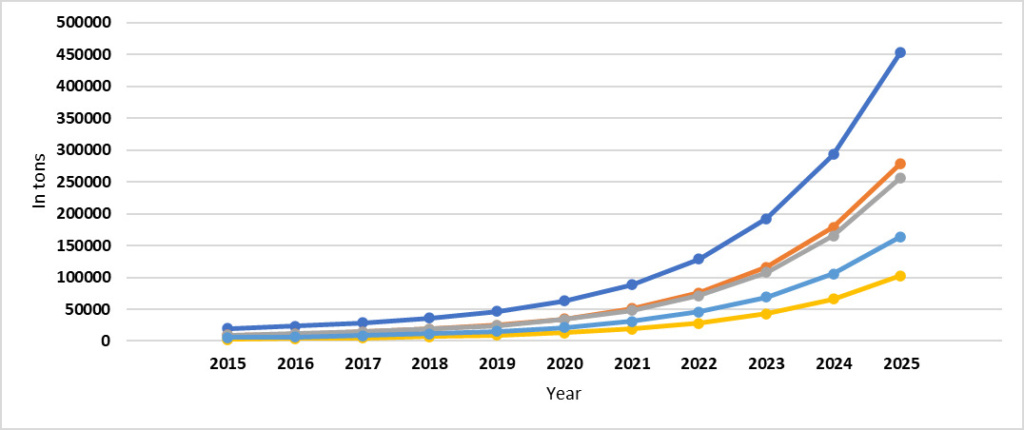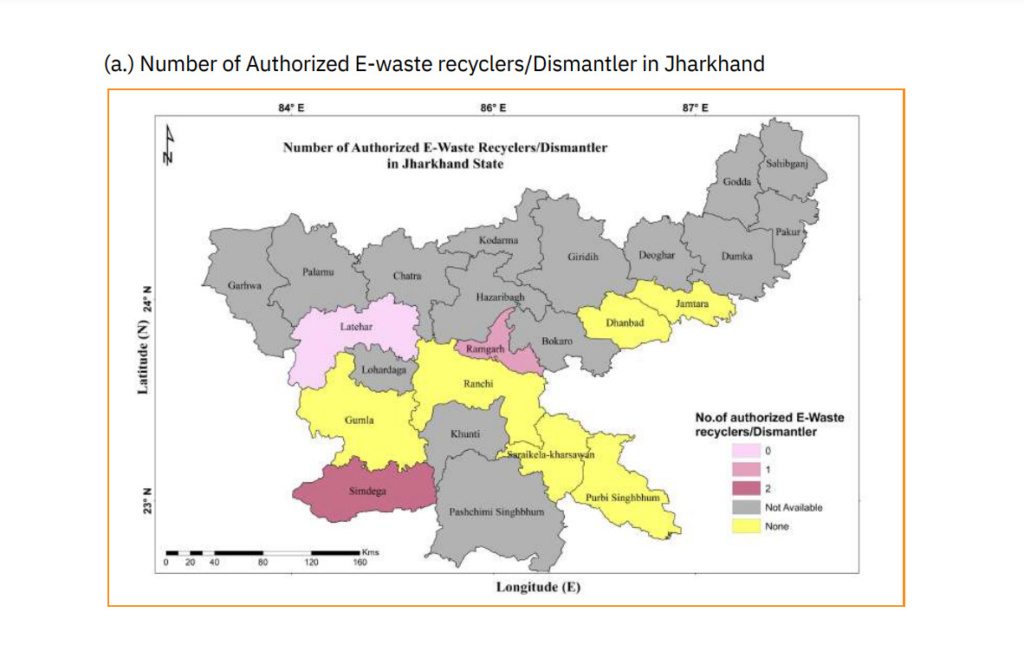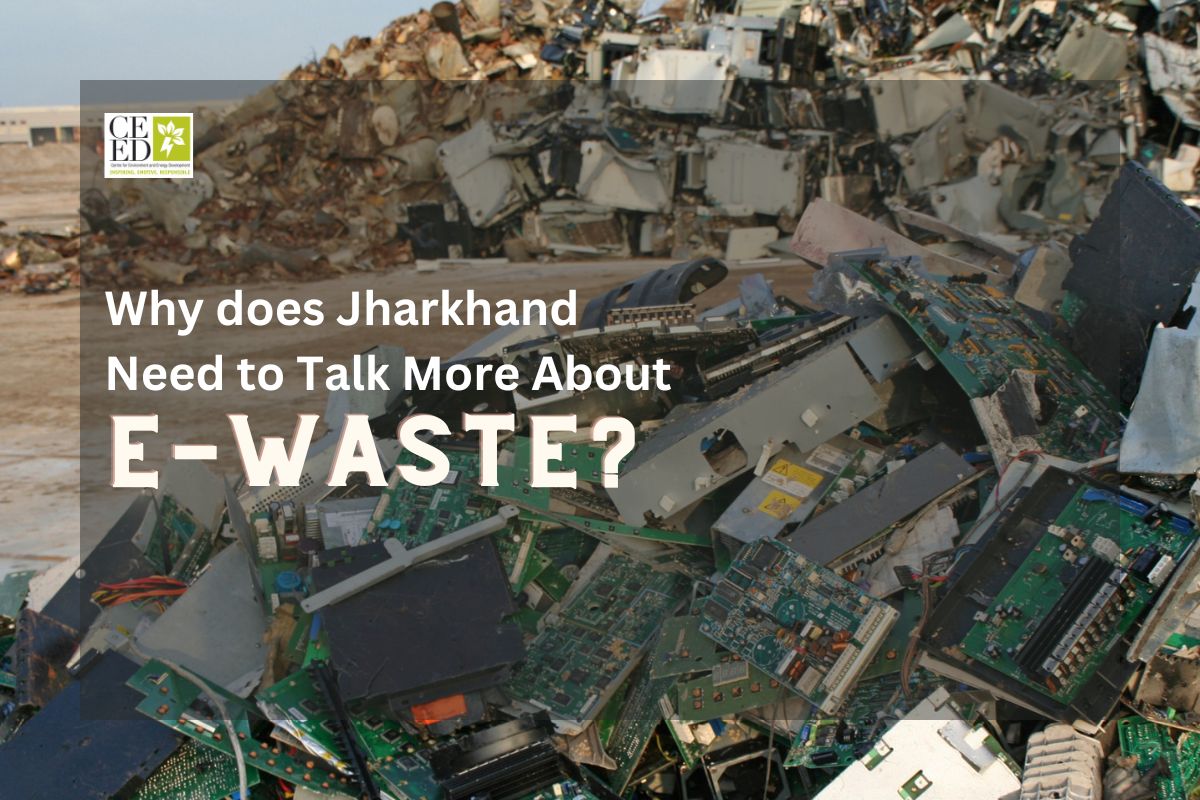Cover Image Source: https://www.mapleleaffoods.com
Unravelling Jharkhand’s Electronic Waste Landscape
Niva Mishra, Manish Kumar |
Introduction
The widespread adoption of modern technology in recent decades has significantly increased electrical and electronic equipment use worldwide. While this has led to improvements in communication and business activities, it has also resulted in a new type of waste i.e. Electronic Waste (E-waste). E-waste refers to discarded electrical or electronic devices and their parts that are thrown away without the intention to reuse. This waste stream is also known as Waste Electrical and Electronic Equipment (WEEE), electronic waste, or e-scrap. It includes a wide range of products such as laptops, mobile phones, refrigerators, televisions, and many other wired and non-wired equipment that often go unnoticed due to their nature or appearance. According to the UN, e-waste is any discarded product with a battery or plug. It features toxic and hazardous substances such as mercury that can pose severe risks to human and environmental health. E-waste is a rapidly growing and complex waste stream that can have adverse effects on human health and the environment, leading to a loss of valuable raw materials. It is important to ensure that these products are included in the electronics recycling stream when they can no longer be reused or repaired.
The increasing number of technology-oriented products in the market has contributed to the rise in e-waste. Household objects such as electric and electronic toys, e-cigarettes, power tools, smoke detectors, wearable health devices, smart home gadgets, e-bikes, e-scooters, and even cables are all examples of invisible e-waste that must be properly disposed of. E-waste, electronic waste, e-scrap, and end-of-life electronics are terms often used to describe used electronics that are nearing the end of their useful life and are discarded, donated, or given to a recycler. It is crucial to take action and properly dispose of e-waste to minimize its impact on the environment and human health.
E-waste is composed of both hazardous and non-hazardous materials, including toxic substances like Cd, Cr, Hg, As, Pb, Se, radioactive elements, halogenated compounds, plastics, glass, ceramics, rubber, ferrous and non-ferrous metals, and precious metals like Au, Ag, and Pt. E-waste generation is estimated to be between 20-50 million tonnes globally and an expected growth of 33%. E-waste management is a major issue for both developed and developing countries. Furthermore, improper disposal and recycling of E-waste can result in severe environmental and health consequences due to exposure to toxic substances and emissions.
Implications to Health, Environment and Circularity
Toxic additives and hazardous substances like mercury, brominated flame retardants (BFR), and chlorofluorocarbons (CFCs) are present in many types of electronic waste (e-waste). If not managed properly, such waste can pose a serious threat to both human health and the environment. Roughly 50 tonnes of mercury and 71 kt(kilotons) of BFR plastics can be found in undocumented e-waste flows, which can adversely impact the health of workers and the environment. Further, E-waste is a major concern as it is not biodegradable and contains toxic materials that can accumulate in the environment. Improper handling of e-waste can expose workers to high levels of contaminants, including lead, mercury, cadmium, and arsenic, which can lead to irreversible health effects. A report published in 2019 recommends a new vision for e-waste based on the circular economy concept, which aims to minimize waste and energy leakage. The report highlights how the improper handling of e-waste results in a significant loss of scarce and valuable raw materials, including precious metals such as neodymium and cobalt, which are crucial for the production of laptops, smartphones, and electric car batteries. Recycling these metals is not only more energy-efficient but also produces 80% less emissions of carbon dioxide compared to mining them from the ground. This highlights the need for sustainable management practices for E-waste.
Global overview of E-waste
The amount of E-Waste generated worldwide is a growing concern that requires attention. According to the UN, in 2021, each person on the planet is producing, on average, 7.6 kg of e-waste, resulting in a massive 57.4 million tons of electronic waste. Only 17.4% of this waste is collected, treated, and recycled properly. E-waste contains harmful substances and precious materials, making proper disposal and recycling essential for environmental and human health. Initiatives are underway to tackle this issue, but consumers play a critical role in ensuring effective e-waste management. The International Telecommunication Union (ITU) has also highlighted that e-waste is one of the largest and most complex waste streams globally. According to the 59.4 million metric tons of e-waste generated in 2022, the ratio will increase by 1.5 times by 2030 when compared with the data from 2010. Efficient material recovery and safe recycling of e-waste are necessary for economic value and environmental sustainability. Currently, less than 1% of the world’s electronic waste is recycled, and the recycling rates of some essential raw materials and valuable metals are also below acceptable levels. This underlines the need for better collection and recycling collection and collection rates as well as for innovative ways to recycle electronic waste and recover valuable resources.

Figure 1: Worldwide E-waste Generation
(Source: https://global-e-waste-statistics)
E-waste Scenario in India
The IT industry in India has played a significant role in the global digital revolution by introducing new smart gadgets and appliances that are used in various aspects of our daily lives. However, this has also led to the creation of a massive e-waste problem, which is causing its own toxic footprint. In India, the recycling of e-waste is primarily carried out by the informal sector of scrap dealers. Thousands of these scrap dealers, commonly known as ‘Kabadiwalas’, sort out the useful and consumable materials from the waste collected and sell them to artisans or industries.
The E-Waste Management Rules were enacted by the Government of India in 2016 and are applicable to industries that produce electronic waste. As per these rules, the maximum duration for storing e-waste is 180 days, which can be extended up to 365 days by the State Pollution Control Board. The existing regulations must be properly implemented and executed to ensure efficient management of e-waste. It is important to integrate both the informal and formal sectors to work together toward sustainable e-waste management. Efficient material recovery and safe recycling of e-waste are necessary for economic value and environmental sustainability.
According to the latest report of CPCB (Central Pollution Control Board), the amount of E-waste produced and recycled is presented in the Figure 2:

Figure 2: E-waste generated and recycled in India
(Source: Central Pollution Control Board(CPCB))
An outlook on the E-Waste in Jharkhand
A study conducted in the developed cities and relatively less developed cities of Jharkhand reveals that the larger and bigger Electrical and Electronic Equipment (EEE) products such as AC, refrigerators, Washing machines, etc., contribute to the maximum volumes and weights of e-waste (JSPCB, 2018). The study suggests that the informal sector accounts for 95% of the recycling that takes place, which is carried out in a toxic and hazardous environment. The Extended Producer Responsibility (ERP) is becoming a fact and figure for a strict requirement for proper tackling of e-waste. It requires the producer or propagators to take back e-waste for recycling or disposal as buyback with or without financial initiatives. However, the lack of knowledge of the user that wastes of EEE also has reusable components can entitle them to good returns often leading to ignorance of consumers to hand back to the manufacturer. The lack of a market for reusable components among the manufacturers also leads to e-waste in bulk, although meaningful components can be extracted and a reduction in waste volumes can be noticed. This surge in e-waste poses significant environmental and health challenges on a global scale. The state of Jharkhand is no exception to this problem, with its rapid industrialization and technological advancements.
According to the inventorization of E-waste conducted in Jharkhand through the data collection from CPCB and JSPCB, the total amount of E-waste generated in 2015 was 46033 tons, and by 2025, it is expected to increase to 1256624 tons (Figure 3). In Jharkhand, residents bring their broken electrical devices to repair businesses, and after replacing any broken or malfunctioning equipment or components, the mechanic sells the vehicle.

Figure 3: Current and Projected E-waste Generation in Jharkhand
Source: Report on E-waste Inventorization in Jharkhand (JSPCB, 2018)
The amount of E-waste in every division of Jharkhand is increasing rapidly, yet it seems like there is no real concern for addressing this issue. The graph clearly shows the upward trend, and it is important that steps are taken to properly manage and dispose of electronic waste in a safe and environmentally friendly way. In the districts of Latehar, Ramgarh, and Simdega, there are very few authorized E-waste recyclers and collectors. Ranchi, Simdega and Hazaribagh have a few authorized E-waste collectors. However, districts, like Ranchi, Dhanbad, Purbi Singhbhum, and others, have no authorized E-waste recyclers, and the data for the entire northern region has yet to be made available (Figure 4).


Figure 4: Number of authorized E-waste (a) recycler /dismantler (b) collectors in Jharkhand
Challenges for E-waste management in Jharkhand
Jharkhand is facing a number of challenges in the area of electronic waste management, similar to those found in many other regions of the world. These difficulties present considerable obstacles to the efficient removal and recycling of such waste, which can lead to environmental contamination and potential health risks. The following are some of the most prominent challenges for electronic waste management in the state:
- Lack of awareness and financial initiatives: The risks associated with incorrect e-waste disposal are not well known to the general population. The issue is made worse by the fact that many individuals continue to throw away electronic equipment in conventional trash containers. Setting up recycling facilities, awareness campaigns, and research projects all require adequate financing. Strong e-waste management solutions can’t be developed because of the cost constraints.
- Environmentally Unsustainable Informal Sector Practices: The informal sector, which frequently uses practices that are hazardous to both the environment and people’s health, manages a sizeable percentage of the e-waste in Jharkhand. Without adequate safety safeguards, workers who engage in informal recycling are exposed to dangerous materials.
- Absence of Producer Responsibilities: Many manufacturers of electronic goods shirk their duty to ensure that their products are disposed of properly at the end of their useful lives. Effective recycling initiatives are hampered by a lack of Extended Producer Responsibility (EPR) implementation.
- Technical difficulties: E-waste is complicated and diversified, with a variety of materials in it. It is difficult to develop technology that can recycle these many components effectively and securely.
- Hazardous Substances: Lead, mercury, and cadmium are among the hazardous materials that are frequently found in electronic gadgets. These compounds can pollute soil and water when handled and disposed of improperly, causing serious health dangers.
- Limited Research and Development: More research and development efforts are required to discover new, environmentally friendly solutions to recycle e-waste. Progress in this sector is hampered by insufficient funding.
A multifaceted strategy comprising government initiatives, public awareness campaigns, commercial sector involvement, investments in research and infrastructure development, and cooperation from all stakeholders is needed to address these difficulties. For the management of e-waste in Jharkhand to be sustainable, cooperation amongst many stakeholders is essential.
Best Practices suggested for E-waste management
Effective E-waste management is crucial in safeguarding the environment and human health. There are several steps that can be taken to ensure proper e-waste management in the case of Jharkhand.

Figure 5: Processes suggesting E-waste management in Jharkhand
Key Recommendations and Way Forward for Jharkhand
- Demarcated and identified disposal point within the jurisdiction that has proper safety measures in place, such as bin covers are extremely required. It is important to dispose of waste responsibly and safely, so it is recommended to check with the local waste management department or municipality to see if they have designated disposal areas for different types of waste.
- E-waste collectors can increase awareness and accessibility of responsible electronic waste disposal options. By making this information publicly available, individuals, businesses, and organizations can make informed decisions about how to dispose of their electronic waste.
- For proper disposal of electronic waste, it is important to transport collected e-waste periodically to the nearest authorized e-waste recycler for recycling. This helps prevent the accumulation of hazardous materials and reduces the environmental impact of improper disposal.
- An awareness program is necessary to educate people about the impact of e-waste on the environment. E-waste is generated by every individual family through the disposal of old electronic devices. Through this program, people can learn about proper disposal methods and the importance of recycling e-waste to reduce its harmful effects.
- Monitoring and reviewing e-waste is crucial for ensuring its proper management and disposal. It is essential to monitor the amount and type of e-waste generated, as well as track its disposal to prevent environmental degradation and health hazards.
References
- https://www.outlookindia.com/national/jharkhand-governor-calls-for-proper-e-waste-disposal-news-280997
- https://pib.gov.in/ e-waste Management
- https://www.jspcb.nic.in/upload/whatsnew/627a59548a092E-Waste%20Management
- http_cdn.cseindia.org_attachments_0.90574500_1609398674
- E-Waste Jharkhand DRF-V AK – 210518-Final Report in E-waste Inventorization in Jharkhand

